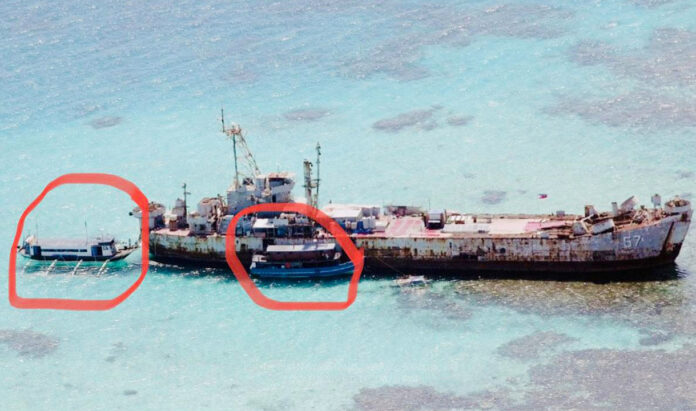THE PHILIPPINES will not remove a ramshackle Navy ship grounded on an atoll in the South China Sea, its Defense chief said on Thursday, rejecting a Chinese demand days after it blocked a Philippine resupply mission.
Second Thomas Shoal, which the Philippines calls Ayungin, lies within the Southeast Asian Nation’s exclusive economic zone “where we have sovereign rights,” Defense Secretary Delfin N. Lorenzana said in a statement.
“That ship has been there since 1999,” he separately told reporters. “If there was a commitment it would have been removed a long time ago.”
The Philippines and China have been in a fresh word war over the sea dispute after China blocked and fired water cannons at Filipino-manned boats that were carrying supplies for marine troops stationed at the shoal.
Troops intentionally grounded the BRP Sierra Madre — a World War II-era vessel acquired by the Philippines from the US in 1976 — at the shoal in 1999 to reinforce its sovereignty claims in the Spratlys.
A 1980s treaty on sea borders that China had signed awarded the exclusive economic zone to the Philippines in the 1980s, Mr. Lorenzana said. “China should abide by its international obligations that it is part of.”
He also cited a United Nations-backed arbitral award in 2016 that voided China’s claim to more than 80% of the sea based on a 1940s map.
The arbitration court “ruled that the territorial claim of China has no historic or legal basis,” he said. “Ergo, we can do whatever we want there and it is they who are actually trespassing.”
“The seemingly peaceful rise of China as an economic superpower coincided with its military aggressiveness in the South China Sea,” Richard J. Heydarian, a professorial chairholder on geopolitics at the Polytechnic University of the Philippines, told a forum on Thursday.
The speed by which China has been catching up with the United States is “mind-boggling and some would say historically unprecedented,” he added.
“Conditions on the ground have actually worsened over the past four or five years despite President Duterte’s efforts to de-escalate tensions,” Mr. Heydarian said.
Mr. Lorenzana told the same forum statistics is not in favor of a peaceful outcome.
“Twelve out of the past 16 cases in which a rising power has confronted a ruling power, the result has been bloodshed,” he said. “As China continues to be a dominant player in global and regional politics, the US is relentlessly confronting its growing influence.”
“Weaker states like the Philippines, unfortunately, are caught in the middle,” he added.
China’s Foreign Ministry spokesman Zhao Lijian earlier asked the Philippines to “honor its commitment and remove its grounded vessel on Ren’ai Jiao,” China’s name for the shoal.
“Ren’ai Jiao is part of China’s Nansha Qundao,” he told a news conference in Beijing. “This position remains unchanged.”
The Second Thomas shoal is located 104 nautical miles from Palawan, an island province in the country’s southwest. The disputed atoll, which is within the Philippines’ 200 nautical-mile exclusive economic zone, is part of the Kalayaan Island Group.
Mr. Lorenzana on Tuesday said the resupply mission had been completed. The boats that carried the supplies would return to Oyster Bay in Palawan after a couple of days.
President Rodrigo R. Duterte, who had sought closer trade and investment ties with China since taking office in 2016, and his Foreign Affairs secretary have condemned last week’s incident. The president called China’s move abhorrent.
The tough-talking Philippine leader told officials from China and Southeast Asian countries at a virtual meeting on Monday stakeholders should exercise self-restraint and avoid escalating tensions in the South China Sea.
The Philippines, China, Vietnam, Malaysia, Brunei and Taiwan claim parts of the South China Sea.
The US, which is not a claimant, has accused China of flexing its military muscle and restricting freedom of navigation there. It has pledged support to its Asian allies, including the Philippines.
The US called the Chinese attacks last week “dangerous, provocative and unjustified,” warning that it would invoke its defense pact with the Philippines in case of an armed attack on Filipino-manned vessels.
The Philippine Foreign Affairs department said in October the country was backing a defense pact that allows Australia to build nuclear-powered submarines using technology that the US had only previously shared with Britain, saying it could keep the balance of power in the Indo-Pacific region.
The South China Sea, which is important for the regional ambitions of China, is a source of tension in the Indo-Pacific as the US and other Western countries continue to assert freedom of navigation.
Mr. Duterte led a foreign policy pivot to China away from the US when he took office in 2016. Less than a year before he steps down, he has since become friendlier to the US. — Alyssa Nicole O. Tan and Kyle Aristophere T. Atienza

